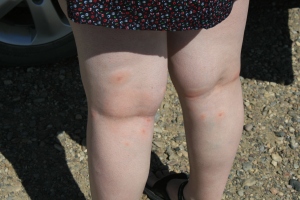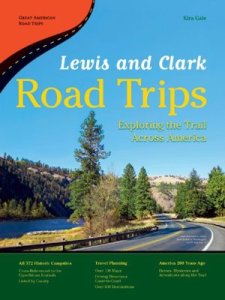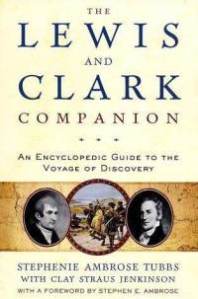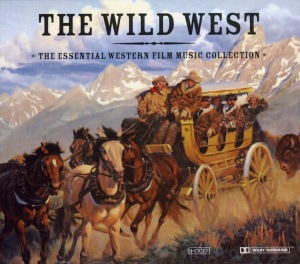After departing Portland, my husband, Simon, and I embarked on what would otherwise have been a two hour drive to our next stop: Astoria, Oregon. We were pulling into the home stretch of the Columbia River’s journey to the Pacific now (and, thus, that of the Lewis and Clark Expedition). Having followed hundreds of miles of the expedition’s river routes over the past year or so, my journey was also nearing its end. I was overwhelmed by a need to see as much of the Columbia as I could on the way to Astoria in order to really savor the final leg of the adventure. Unfortunately, the river flowed through quite a rural area here and was therefore not visible from the highway the majority of the time. We were about fifteen miles from where the Columbia finally turns into an estuary, so, wanting to get a last look at the river which had borne the Corps such a long way, I drove off down a road though farmland. I blindly headed north for several miles, knowing we would eventually meet up with the river somewhere.
After a while, a sudden parting of the trees revealed an expansive sandy ridge with an ENORMOUS CONTAINER SHIP gliding along on top of it only a couple hundred feet away from us. I’m from un-beach-savvy Colorado, so this completely threw me for a loop, and immediately the car was lured off the road and out onto the sand. The thought of a ship of such immense size passing so close to the bank of a mile wide river (to avoid islands, it later turned out) pretty much caused me to have an out of body experience. A little voice (which sounded suspiciously like my own) commanded me to drive to the top of the ridge, park, and let the drool dribble freely from the amazed mouth I was no longer able to close. Eager to obey, I proceeded to drive the car about 100 feet out into the sand, where it promptly plowed its way to a stop.


As we got out of the car to assess the situation, I soon found out the secret ingredient behind sandy ridges with wide views: their exposure to constant, lashing wind. We stepped out into the sandstorm, barely able to see, function, breathe, or communicate. We took turns braving the elements and trying to dislodge the car while the other one attempted to drive it forward or backward or, rather, get it to move even an inch. We had to keep the driver’s side window cracked to even attempt to hear each other, so sand blew in and covered all our possessions and started mounding up about half an inch deep in the back seat. The car would not budge and was beached up to the axles.
Needless to say, it was not a good look for our silver, late model Ford Mustang rental car. We had originally arranged to rent a cheapo compact car for our vacation but, “Nooooo!” the lady at the rental agency had said on our arrival, “You want something ‘fun to drive’ for your special trip! It will only be $10 per day extra!”
We prayed to whichever gods were tasked with babysitting dumb tourists. Nothing happened. A sacrifice seemed in order, so we placed my beach towel under a rear wheel of the car. The wheel spun helplessly and destroyed the towel. We wedged Simon’s flip flops under the rear wheels and tried to get the car to move. It would not budge.
We had been so distracted we had missed getting to look at the ship, and it was long gone. To add insult to injury, by this time it had dawned on me that the Columbia River, at this proximity to the Pacific, was now tidal (Lewis and Clark had even remarked on it). And the car was right by it.

A half hour later, we gave up and started walking down the road, wondering if we would ever see the car and our possessions again. I quit smoking three years ago, but would have chain smoked every cigarette in a pack, had I had one. Simon’s fancy cell phone had no signal and my ancient one (which is such that I basically have to wait for a stonemason to come chisel my text messages) didn’t, either. I knew that we were about 30 miles away from both Astoria, Oregon and Longview, Washington (in opposite directions), but none of that really mattered considering we were miles from even the nearest hamlet. I sulked down the country road for a ways until my phone, on its final flashing bar of battery and with less than five minutes of pre-paid time remaining, finally got the vaguest of signals. I called my car insurance and jabbed repeatedly at the “zero” button until I got hooked up with a choppy connection to a lady I pictured as being in a call center in Cincinnati, Ohio.
“Do you mind if I ask you a few questions in order to provide you with the best service possible?”
“Um, well, you see…”
“Are you and your car in a safe place right now?” she carried on.
“Yes. Um, well, it’s stranded on sand on a remote, tidal beach in a rural area and I have five minutes of cell phone time left, three of which I have used getting through your automated menus,” I replied (at least in part).
“Where are you located?” she asked.
“Um, I’m next to the Columbia River, near umm…” I trailed off, recalling that the Columbia starts somewhere in Canada and I was basically near the northwest most point of Oregon, “Marshton? Uh… Marsh…dale?”
“I can’t seem to find that.”
“Uhhh, well, we passed a tiny town a ways back on the highway. What was it, Simon? Uh, I should have paid more attention.” At a complete loss, I started stringing together promising-sounding fragments of Pacific Northwest town names, “Uhhh, Skanatamia? Skintasie…? Scocsalosie…?”
“How do you spell that?”
I spent the next thirty precious seconds participating in the most important spelling bee of my life.
“I’m sorry, but I’m not finding those, ma’am.”
“Well, I KNOW we’re kind of near Astoria, Oregon…” (Thirty miles away, ahem.)
The signal was continuously breaking up and we could barely hear each other, anyway, so the phone decided to call it quits on our quasi-emergency rescue.
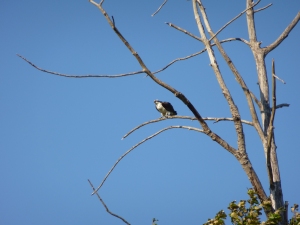

Simon and I carried on walking down the country road. It was a beautiful place to be stranded in, with a golden sunset streaming across the green fields, distant hills beyond them on our right, and the river peeking through the trees on our left. The rapidly setting sun highlighted the red and yellow apples on nearby fruit trees in a charming way, as it did the barbed wire and the (presumably poison) ivy along the road. I began to think the powers that be were gifting me with a small slice of adventure in order to put me closer in touch with the perils endured by Lewis and Clark’s party. I even started to fantasize a little about the possibility of having to sleep on the beach next to the Columbia. Maybe we would even get attacked by a grizzly bear and, in a heroic act similar to those of Lewis and Clark, I would throw my disabled cell phone at it and it would fall down dead! Perhaps we’d then even get to try grizzly bear stew and…
Simon, meanwhile, was mainly upset that technology had failed us in pretty much every possible way, and was storming silently down the road, fists balled at his sides.
I tried my hand at some humor to lighten the mood: “Honey, I think now is an appropriate time to let you know that, if I die, you have my permission to eat me in order to keep yourself alive until you reach Skuccapaloosa.”
He was not amused. Someday, he would look back on this and laugh. Someday, perhaps twenty years after you read this.

The shadows of the trees stretched ever longer across the road and, after walking about two miles, we finally came upon a farm house. The clinks of the wind chimes on its porch were about the only sounds in the surrounding rural quietude. An errant cat slinked by in the yard. Simon and I hesitated, urging each other in sharp whispers to be the one to act as spokesperson. That dirty deed, of course, fell to the one who got us in this mess. I walked gingerly down the path to the front porch, followed by a reluctant Simon. We were careful to not disrespectfully step on so much as a blade of grass. As we climbed up the stairs, I heard the TV going in the front room. I nudged and hissed at Simon in a last ditch attempt to get him to ring the doorbell and do the talking, but had no such luck.
A middle aged Native American man in a plaid flannel shirt and jeans came to the door, with a suitably guarded look in his eyes. Don’t get strangers much ‘round these parts, I expect.
“Hieeeeeeee!” I blurted out lamely, but with as much cheerfulness as I could muster in case he had his rifle at hand. I could smell grizzly bear stew cooking somewhere in the depths of the house.
“I am so, SOOOOO sorry to bother you, sir, but I got my car stuck in the sand a couple miles down the road and neither of our cell phones are working,” I explained, thinking to myself, “Wait, do they know what cell phones are around these rural parts? Did that make me seem like too much of a city slicker? I’m not wearing anything which smacks too much of haute couture, am I? Oh wait, nope, just a sand encrusted t-shirt and jeans. Good. He’s used to being sand encrusted. Yes. Why, I blend right in.”
“Could I please use your phone to call my car insurance? It’s toll free!” I said reassuringly.
He looked from me to Simon and back to me, as if he wondered just what the two of us were going to steal from or try to sell him, then closed the door. He came back a minute later with a cordless phone, handed it to me and shut the door again. I got back on the phone with my insurance.
“Hi! It’s me again! I’m the one who’s stuck in sand in Oregon!”
Apparently, call centers have more than one person working in them and this new person knew nothing of my plight. I had to explain the whole thing and answer the whole barrage of questions all over again. Dumb as I am, I even repeated my whole spiel about, “I think we’re near Skanatamia or somewhere!” again until I got the bright idea to summon Mr. Farm Man, ask for his address, and pass that along to the rep.
“You haven’t met your deductible yet, so there’s a $160.00 charge for this which will need to be pre-paid by credit card,” she informed me. I think I would have agreed to anything up to about $2,000.00 before walking 28 more miles or asking for a ride from Mr. Farm Man, so I hastily forked over my credit card details.
After the call ended, I knocked on the door so I could give the phone back. To my relief, a little boy of about eight came to answer it this time. His Wii game was paused on the TV and I was pretty sure there was a trickle of grizzly bear stew running down his shirt. I gave him the phone, thanked him profusely, and pressed three crispy dollars into his other hand. Then Simon and I hightailed it down the road a ways, just far enough so that the barn was between us and the house. That way, we were out of sight and could be ashamed in private.

We stood by the side of the road watching the sun sink behind the hills and the sky filter through increasingly darker shades of blue. The family’s horses came trotting over to the barbed wire fence next to us, looking for food, but soon went away disappointed, pouting behind the anti-sand face guards they wore. An hour passed and we still waited, looking constantly in all directions, not knowing when or from where the tow truck would be coming. We didn’t know if they would even be able to find us out here, and we would never know if they were having trouble, anyway. We were supposed to be staying at a bed and breakfast in Astoria that evening, and I was wracked with guilt thinking back to the reservation I had made. I had spoken to the owner, who had informed me she was a wheelchair bound lady in her nineties, and that she would be locking the B&B up promptly upon her bedtime of 8:00pm.
A car (the first vehicle we had seen) started coming down the road, and we threw ourselves into a charade of brisk walking so as not to look like forlorn, stranded Coloradoan tourists. The car slowed down as it approached. It was a long, trundling 1970s car of a macramé colored brown and orange; the kind of car you expected to transform into a low rider at any moment. We tried to look confident and local. The 50-something driver rolled down his window.
“Hey, my mom’s been missing since ten this morning. You haven’t seen anyone walking around here, have you?”
“Um, nope! We’re just out for a walk, ourselves!” we said, oh-so-convincingly. (Please don’t kidnap us and put us in the trunk with your mother.)
But then I remembered that, somewhere in the excitement of seeing the container ship, we had seen an old woman wandering around aimlessly, all alone. We had been slightly concerned about her being out in the middle of nowhere, particularly upon seeing her sauntering along with an empty, inane grin on her face.
But hey, man – giant container ship.
I relayed this information to the man (in a more polite fashion) and he thanked us and drove off.
We resumed waiting another half hour or so in the gathering dusk until finally I saw a bright red tow truck far across the fields, spewing up dust in its wake. WE WERE SAVED! We stationed ourselves in the middle of the road and flagged the driver down. Our savior had come in the form of the very gruff and to the point Phil, of Nottobenamed Towing, based in Longview, Washington (or at least the patch on his shirt introduced him as such). My heart soared with relief.

He drove us back to where I had taken the car on its off road adventure, and got out of the truck. Phil’s baseball cap indicated he was an ex-Navy serviceman. From under it, his blue eyes surveyed the wind-whipped expanse of sand, our rental car marooned pathetically in its midst. An astounded whistling noise escaped from his pursed lips.
“Is that it over there?” he asked, as if perhaps hoping a less pathetically marooned car would be somewhere nearby.
We nodded. Phil began to look alarmingly perplexed. I wasn’t entirely sure if he really was perplexed or if the next words out of his mouth were going to be a carefully rehearsed, “Well, this is gonna cost ya. I’m gonna have to drive back to Longview to get ole’ Bessie, the heavy duty tow truck. She has the only crane we got.”
Instead, Phil walked over to the car to size up the situation. Dusk was definitely on its last legs and the now bitingly cold wind was still blowing sand around like crazy.
“Damn, if I knew it was gonna be THIS cold, I woulda brought my coat!” Phil whined accusingly at us. I had no coat and had been standing around in the cold for two hours. I motioned to Simon to give Phil his own meager jacket or, hell, all his clothes – whatever it would take to keep Phil around – but Phil was already trudging through the sand back to his truck. He dug around in the back and started dragging one end of a winch towards the car. As he got within about 20 feet of the car, his 100 foot long cable ran out of slack. Not to be deterred, ex-Navy Phil produced another short length of cable, a length of chain, and a strap, and managed to somehow cobble them onto the winch.
Less to our liking, he also produced a waiver. He explained that, since the car had no towing hitch or any other means by which to attach the winch concoction, he would have to pass the strap through one of the rear wheels. We whimpered remorsefully that this was not our real car, but a rental car. He threw his hands up and said he didn’t know what was going to happen and that he couldn’t be responsible for any damage. On his waiver, I scrawled what I imagined was a $40,000 signature.
Phil plodded off again and, over the wind, barked orders at Simon. Simon then barked orders at me to get away from the car because, when Phil started towing, the cable might snap and decapitate me. Comforted by this pleasant thought, I grabbed the remnants of the sacrificial beach towel and flip flops from under the wheels and ran off through the sand as quickly as I could. That is to say, I did that pitiful, running-on-a-moving-walkway-type-thing which happens when you try to run in sand, losing two steps for every one taken.
Phil reached his truck and turned on the engine. The headlights shot two bright yellow beams through the whirling sand. He started running the winch and, far away at the other end, the rental car did nothing. He got out of the truck again, went back to Simon, accused him of having the brakes on, checked all the connections of his jerry-rigged winch, and then tried running the winch again at an increased speed. He repeated all five of these steps another two times until, finally, the car started plowing backwards through the sand. Simon was at its helm, doing everything he could to keep it sliding in a vaguely straight path by its one rear wheel. After a few tense minutes, success, and Phil barricaded himself in the cab of his truck and started filling out more paperwork.
An old guy in a pickup truck was driving past on the road. He slowed and congratulated us with something to the effect of, “Oh, you got it out in the end!” I imagined our sob story had spread like wildfire through the sleepy environs for miles around. He drove off into the night, presumably to pass the news along to Ethel, Jack, and Henry.
A few minutes later, a drunk guy on a dirt bike came out of nowhere, buzzing over the sand like an obnoxious, conceited bee. He seemed genuinely disappointed that our car had been freed. He spent what seemed like the next half hour engaged in a rambling, repeating, one sided conversation something to the effect of, “Awww, you got a tow truck? Why didn’t you ask me for help! I woulda pulled you out!”
Finally Phil emerged from the cab. As usual, he was all business. While we finished up the paperwork, I tried to make some pleasant small talk and thanked him for his service to our country in the navy. He looked very surprised that I knew about that until I gestured towards his hat. The thought of his navy service caused Phil to finally bloom with conversation and he turned out to actually be quite charming. He told us a bit about it and announced with pride that he had served on the ship from which Osama bin Laden’s body had been disposed into the sea.
At last it came time to tip him, so I gave him the $50 we had. He seemed happy enough, but so great were his efforts and our relief at being rescued that I whipped out my checkbook.
“This is all the cash we have, but can we give you a check as well?” I accosted him, pen at the ready. He looked very honestly surprised and taken aback. He thought about it for a moment and finally decided, “Well, you can do whatever you wanna do, I guess. It’s a free country.”
I handed him a pretty nice check and thanked him profusely (at one point coming dangerously close to worshipping at his boots). I told him I supposed this call out would make it to the top of the Wall of Fame back at his towing place, if there was such a thing. He seemed to agree, and went on his way.
As Simon and I were about to get in our car, the driver of the 1970s car drove past, slowing to give us a quick wave, and shouting out, “Thanks again!”
Secured safely in the front seat, his mother grinned inanely at me again; this time at my sand encrusted idiocy.








